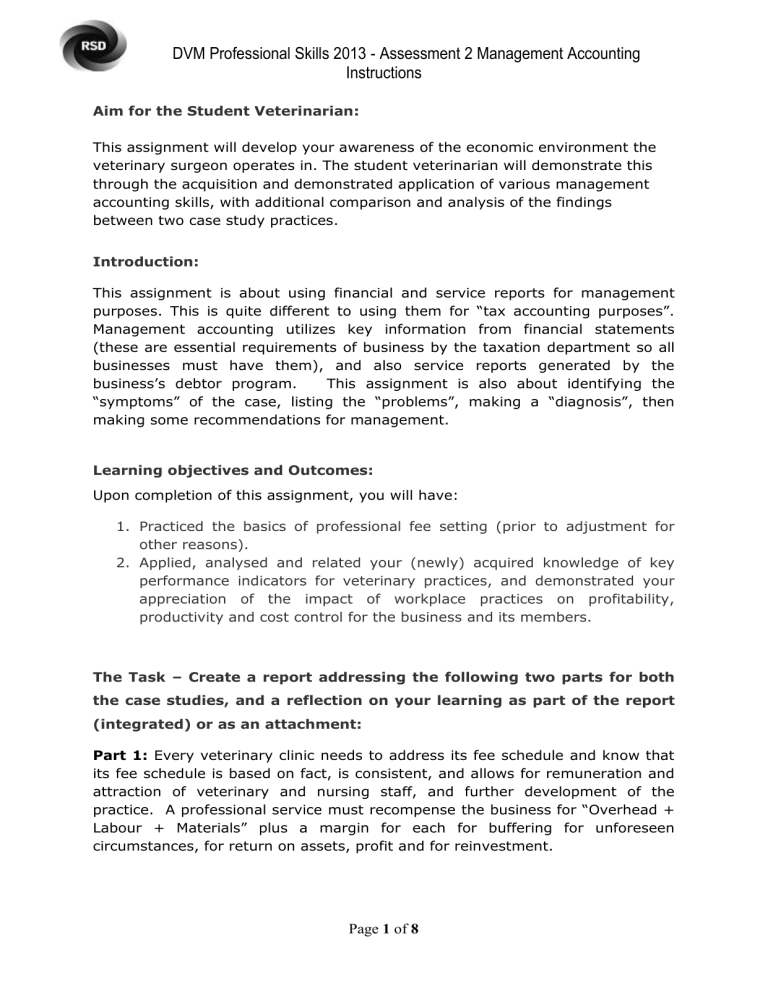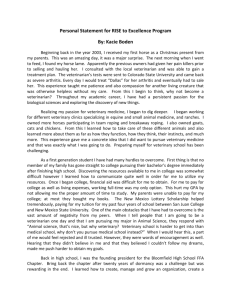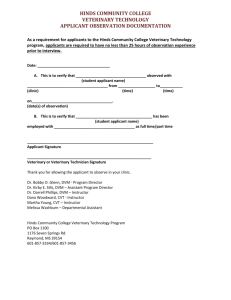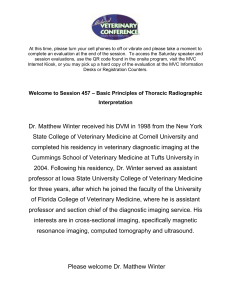DVM Professional Skills - University of Adelaide

DVM Professional Skills 2013 - Assessment 2 Management Accounting
Instructions
Aim for the Student Veterinarian:
This assignment will develop your awareness of the economic environment the veterinary surgeon operates in. The student veterinarian will demonstrate this through the acquisition and demonstrated application of various management accounting skills, with additional comparison and analysis of the findings between two case study practices.
Introduction:
This assignment is about using financial and service reports for management purposes. This is quite different to using them for “tax accounting purposes”.
Management accounting utilizes key information from financial statements
(these are essential requirements of business by the taxation department so all businesses must have them), and also service reports generated by the business’s debtor program. This assignment is also about identifying the
“symptoms” of the case, listing the “problems”, making a “diagnosis”, then making some recommendations for management.
Learning objectives and Outcomes:
Upon completion of this assignment, you will have:
1.
Practiced the basics of professional fee setting (prior to adjustment for other reasons).
2.
Applied, analysed and related your (newly) acquired knowledge of key performance indicators for veterinary practices, and demonstrated your appreciation of the impact of workplace practices on profitability, productivity and cost control for the business and its members.
The Task – Create a report addressing the following two parts for both the case studies, and a reflection on your learning as part of the report
(integrated) or as an attachment:
Part 1: Every veterinary clinic needs to address its fee schedule and know that its fee schedule is based on fact, is consistent, and allows for remuneration and attraction of veterinary and nursing staff, and further development of the practice. A professional service must recompense the business for “Overhead +
Labour + Materials” plus a margin for each for buffering for unforeseen circumstances, for return on assets, profit and for reinvestment.
Page 1 of 8
DVM Professional Skills 2013 - Assessment 2 Management Accounting
Instructions
A.
Use the recent profit and loss statement supplied for your case study practice and the current opening hours to arrive at a raw cost “per ten
(10) minutes per veterinarian” overhead rate. Assume that the veterinarians are billing at an efficiency of “50% of their time billed” so adjust for this when you calculate the overhead rate. Remember to spread the full time vet equivalents over all the opening hours.
B.
Use acceptable professional fee rates and high level nurse rates to arrive at “per ten minute” labour rates. Assume as above, that the veterinary staff are able to bill 50% of their time, so adjust for this when you calculate labour rates.
C.
Show your method of fee construction, using the above, to create FOR
BOTH CASE STUDIES: i.
a standard fee for a pre-anaesthetic profile run by one nurse*: assume: a.
nurse time of ten minutes, b.
overhead raw cost of ten minutes, c.
machine costs included in the overhead raw cost, and d.
$24 for a pre-anaesthetic profile test kit.
* assume qualified Certificate IV Nurse. ii.
a standard fee for intravenous fluids set-up by two nurses: assume two nurses, ten minutes each, overhead raw cost of ten minutes,
$7.02 raw cost for intravenous line, intravenous catheter, fluid bag, strapping. iii.
a standard fee for anaesthesia – assume one veterinarian for ten minutes induction (who then proceeds to be the surgeon), and one nurse* (as above assume is a qualified nurse) for 60 minutes (who will help induce and stabilize with the vet, clip and prepare the abdomen, and monitor the anaesthetic while the vet operates), including raw variable costs for premedication (acepromazine and methadone) $4 and anaesthetic $12 (isoflurane and oxygen). Do not forget the facility overhead component in some way.
Page 2 of 8
DVM Professional Skills 2013 - Assessment 2 Management Accounting
Instructions iv.
a standard fee for the surgery component for a 40 kg dog spey
(ovariohysterectomy) – assume 40 minutes veterinary time, 40 minutes overhead time, and a total raw cost of $20 for all of the following variable drug and material costs: pain relief (meloxicam post op, and take home tablets for 3 days), suture (cassette PDS, skin sutures) and swabs (1/2 packet). v.
a mock tax invoice for a nine year old Rottweiler bitch which has had (i) + (ii) + (iii) + (iv) vi.
Compare (v) for each practice to that which would be charged by the practice as per the provided fee schedule (will be a bundled fee
“spey” = anaesthetic and ovaro-hysterectomy surgery). vii.
an estimate for a six kilogram, eight year old Jack Russell “Ralph” for a pre-anaesthetic blood screen, intravenous fluids, then general anaesthetic (gas) for dental extractions and a “scale and polish”
(also known as a dental “prophy”). For this calculation, base the estimate on (i), (ii), (iii) plus your calculations for a high level nurse time of twenty minutes for the “scale and polish”, vet time of twenty minutes for the extractions of multiple incisors and the two abscessing but still quite attached tricuspid molars, and a total raw cost of $28 for drugs and disposables (pre-medication, postoperative pain relief and nerve block, and prophy paste) and with a course of antibiotic tablets one day prior and continuing six days post surgery at raw cost of $29.40.
D.
Briefly compare and contrast your calculated fees for the items above for each practice, and what the fee schedule for the practice shows. Why might there be a difference between the calculated fee and the actual fee charged for each practice? What are your thoughts about the difference between the two case study practices’ actual fees and calculated fees?
Part 2: Use the financial statements and the service report exhibits for each of the case study practices to calculate or obtain three key performance indicators
(KPIs) in each of the areas of profitability, productivity and cost control (i.e. to a total of nine). Summarize, compare between each case study practice and discuss your findings for these nine Key Performance Indicators. Explain why you chose to discuss these particular KPIs. What do the results mean for each of the practices (Ackermann 2007; Katz 2007; Stowe 2004)?
Page 3 of 8
DVM Professional Skills 2013 - Assessment 2 Management Accounting
Instructions
Include within your assignment self critique/reflection on the assignment.
Guidelines for this are: a.
Relate the development of the task to your own skills, knowledge or prior experience prior to the course. Have you done this type of task before?
Were the conditions the same or different? Did you feel you had the skills and knowledge to undertake this assignment? b.
Highlight in detail the significant limitations or good points to your enquiry path and concepts that you discovered when you actually undertook the investigation. Explain why and how the quality of the calculations did or did not achieve what you wanted. Refer to some relevant theory or literature to support your reasoning. c.
Comment on how you would approach such tasks as the above in a real veterinary business. What might work and why? Are there different options? Are your ideas supported by theory or publications?
Steps:
1.
Complete, if you have not previously, the following specific modules within the Writing & Speaking at Uni (AU LTDU 0004) course which is on your My
Uni Site (lower right hand corner).
Cohesive Writing Module pages 1 – 14
Communication Skills Module 2 Grammar Issues
Communication Skills Module 3 Punctuation and Word Choice
Communication Skills Module 4 Paragraphs for practice
Communications Skills Module 1 Sentence Structure
2.
Individually undertake the required pre-reading prior to each Workshop.
3.
Participate actively with your team in the Wednesday morning workshops which underpin this assignment. Use the time to gather information and ideas from the activity.
4.
Use both case studies for the data upon which to base your answers.
5.
Address the task (see above).
Page 4 of 8
DVM Professional Skills 2013 - Assessment 2 Management Accounting
Instructions
Page 5 of 8
DVM Professional Skills 2013 - Assessment 2 Management Accounting
Instructions
6.
Please check your work for text matching and adequacy of referencing. Pass a word document of your assignment through Turnitin prior to lodgement
(this will be available in the Assignment area for each assignment). This is required as part of the assessment.
7.
Please indicate your self assessment also prior to lodgement. To do this, for each criterion, consider the levels to which you met each criterion, and highlight these areas in the rubric (do not score).
8.
Submission: Electronically into both Turnitin and MyUni.
Note, for Turnitin, DO NOT include your cover sheet, task sheet or self assessed marking rubric.
Note, for MyUni, DO submit your cover sheet & self assessed marking rubric into the MyUni electronic lodgement location. Please attach these IN THE
SAME LODGEMENT as your actual assignment answers (i.e. attach both documents together).
Assignments that are late without an approved extension will NOT be marked.
Assignments that are late with an approved extension, must be also submitted in hard copy, as well as electronically submitted.
Extensions can only be granted for health or compassionate reasons (same rules as for approved absences).
References:
Ackermann, L 2007, Blackwell's Five-Minute Veterinary Practice Management
Consult, First Edition edn, Blackwell Publishing.
Katz, JAG, R P 2007, Entrepreneurial small business, ed. JE Biernat, McGraw Hill.
Stowe, JD 2004, The Effective Veterinary Practice Beyond Management, second edn, ed. L Ackerman, Lifelearn Inc.
Page 6 of 8
DVM Professional Skills 2013 - Assessment 2 Management Accounting
Instructions
This Assignment is an indicator of the following:
Royal College of Veterinary Surgeons Day I skills:
A1.1 Communicate effectively with clients, the lay public, professional colleagues and responsible authorities; listen effectively and respond sympathetically to clients and others, using language in a form appropriate to the audience and the context
A1.5 Be aware of the economic and emotional climate in which the veterinary surgeon operates, and respond appropriately to the influence of such pressures
A1.6 Be willing to use one's professional capabilities to contribute as far as possible to the advancement of veterinary knowledge in order to benefit veterinary practice and further improve the quality of animal care and public health
Graduate Attributes of the University of Adelaide:
Research Skills: The ability to locate, analyse, evaluate and synthesise information from a wide variety of sources in a planned and timely manner.
Knowledge & Understanding of the content and techniques of a chosen discipline at advanced levels that are internationally recognized. ie. demonstrates knowledge of written communication importance within the discipline context and utilises this.
Skills of a high order in interpersonal understanding, teamwork and
communication.
A commitment to the highest standards of professional endeavour and the ability to take a leadership role in the community.
An awareness of ethical, social and cultural issues within a global context and their importance in the exercise of professional skills and responsibilities
Page 7 of 8
DVM Professional Skills 2013 - Assessment 2 Management Accounting Marking Criteria
Your Name:
CRITERIA
The student has demonstrates the following facets of inquiry…
Your Group:
0 - 1 points
Fails to satisfy the minimum requirements
a. Embark & Clarify Determines what knowledge is required and the purpose of the report
Misses the point.
No attempt to introduce the purpose of the report b. Find & Generate needed information/data using appropriate methodology
Does not collect required information or data using methods in critical readings and the case studies
c. Evaluate & Reflect Determine and critique the information and data generated and reflect on the processes used.
Insufficient, and scant evaluation and reflection on reporting process d. Organise & Manage
Organise information/data to reveal patterns and themes, and manage teams and research processes. e. Analyse & Synthesise,
Analyse information/data critically and synthesis new knowledge to produce coherent understandings f. Communicate & Apply Ethically
Write, present and perform the processes, understandings and applications, and respond to feedback, accounting for ethical, social and cultural (ESC) issues
None
Blurred logic to organisation
Simple structure, linear process.
Just reproduces existing information in prescribed structure
Uses mainly lay language to demonstrate understating for lecturer/teacher as audience.
Poor layout, grammar, spelling, clarity, flow.
2 – 4 points 5 – 7 points 8 – 10 points
Final
Prescribed Level of Attempt
(Just fails to satisfy the minimum requirement)
Bounded Level of Work
(Satisfies minimum requirements
& Demonstrates sound
understanding)
In an introductory paragraph the student veterinarian clarifies the purpose of the report.
Some logic and shows some evidence of use of methods from the critical readings and/or the case studies as resources
Undertakes an appropriate in depth consideration of the purpose of the report and its associated underpinning tasks, shows own curiosity.
Utilizes the data provided in the case studies and follows methodology and examples supplied, shows own determination.
Evaluates and reflects on the calculations.
Organises the information and data and manages the process clearly and effectively using the provided guidelines.
Plus asks and answers questions of clarification
Uses some veterinary business language to demonstrate understanding.
Lecturer/teacher as audience. Many errors Spelling & Grammar, Scant OR too wordy or verbose. Scant referencing to references or readings
Evaluates information/data calculated against the pre-existing fee schedule for each case study practice. Reflects insightfully to improve own processes used. Relates to own skills, knowledge or prior experience; shows discernment
Organises the information and data and manages the process by adapting provided guidelines, acknowledges team members inputs; shows harmonizing
Plus: constructs emergent level knowledge exhibiting gain of new understanding e.g. asks and answers relevant questions; shows creativity
Uses veterinary business language which demonstrates understanding to colleagues in the profession.
Minor errors Spelling & Grammar.
Some referencing, but highly pertinent. , shows constructiveness in report, going clearly to where the gap is needing to be filled for the case studies.
Uses Scaffolding combined with independent enquiry
(A very high standard of work which demonstrates originality and insight)
In the introduction shows the purpose of the report inviting curiosity, shows what knowledge (real world) is required for the tasks, Beckons the reader to follow
Plus- uses notes t o each step to “lead the reader through the steps taken for each task.
Plus: shows some further research and reading into the methodology.
Breadth and depth shown in calculations
(e.g. use of explanatory notes) and in evaluation of information used.
Comments/discusses future approach to such an analysis, and improvements which might be made to the process.
Highly organised and managed showing further discussion of the pros and cons of the provided guidelines for calculations
Plus: analyses and synthesizes information/data to fill self identified knowledge gaps. E.g. asks rigorous questions based on new understandings.
Professional and innovative presentation
(i.e. as a report to owners) with an awareness of ESC. Cohesive, plain language used. Beckons the reader to follow the process. No errors in grammar, spelling. Strong evidence of independent reading & knowledge beyond core material & references
/ 60
%
Page 8 of 8






